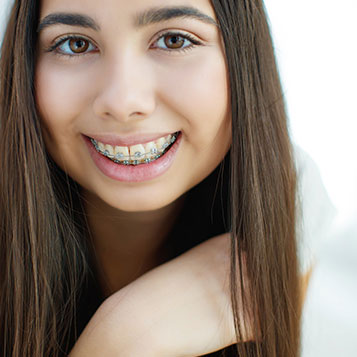Life with Braces
The best way to ensure a clean and healthy smile is with brushing and flossing. Food particles can accumulate on teeth and in braces, and over time, turn into plaque. This can result in gum disease, tooth decay and even loss of teeth. To avoid these problems while you are in orthodontic treatment, take special care of your braces, teeth, and gums to ensure you will have the best possible result.
Brushing
Use a toothbrush with soft bristles and a small strip of fluoride toothpaste. When brushing your teeth, move the toothbrush in small, circular motions Brush slowly and carefully, covering the area between the teeth and gums. It will take you several minutes to thoroughly brush your teeth.
During orthodontic treatment, brush your teeth at least three times daily, especially after eating, to avoid the accumulation of plaque and food particles on your teeth and braces.
You will need to replace your toothbrush more often due to your braces. As soon as the bristles start to wear down or fray, replace your toothbrush with a new one.
Flossing
For areas between the teeth that a toothbrush can't reach, use dental floss to remove food particles and plaque. Flossing takes more time and patience when you are wearing braces, but it is important to floss your teeth every day.
Use the reusable floss threader provided by our office to floss under your archwire daily. Pull a small length of floss through the floss threader and guide the floss threader with your floss under your archwire. Slide the floss in an up and down motion between each tooth making sure you floss gently under the gumline. Use care around your archwire, and do not floss too forcefully around it or put too much pressure on it. After you floss between your archwire and braces, floss between your other teeth and gums.
Floss at night to make sure your teeth are clean before you go to bed. If you have not been flossing your teeth on a regular basis, your gums may bleed a little. If the bleeding does not go away after the first few times, inform a staff member at your next appointment.
Dental Check-Ups
Dr. Kubik works closely with your family dentist. Regular check-ups with your family dentist are important while in braces. Your dentist will determine the intervals between your cleaning appointments while you are in treatment.
Foods to Avoid
Foods that are hard, sticky or high in sugar must be avoided. Hard and sticky foods can break, damage, or get caught between your wires and braces. Minimize sugary foods because they cause tooth decay. Nail biting, pencil and pen chewing, and chewing on foreign objects should also be avoided as these too can cause damage to your braces and wires.
Examples of Sticky Foods to Avoid:
- Gum (sugar-free or regular)
- Licorice
- Skittles
- Gummie Bears
- Tootsie Rolls
- Caramels
- Starburst
Examples of Hard Foods to Avoid:
- Ice
- Nuts
- Hard taco shells/chips
- French bread crust/rolls
- Corn on the cob (unless cut off the cob)
- Apples and carrots (unless cut into small pieces)
- Bagels
- Jolly Ranchers
- Pizza crust
- Cough drops
Minimize Sugary Foods like:
- Cake
- Ice Cream
- Cookies
- Pie
- Candy
Drinks to Avoid:
- Soda (or any carbonated drink)
- Sweetened tea
- Gatorade (bottled)
- PowerAde (bottled)
- Juice Boxes
- Canned drinks, such as lemonade or iced tea
- Energy drinks
It is safe to consume milk products and drinks made with tap water, such as Crystal Light, Gatorade, lemonade, and Kool-Aid. It is important to minimize your sugar intake.


